3-Row SUVs Compared: Explorer, Telluride, Palisade, Enclave, and CX-9
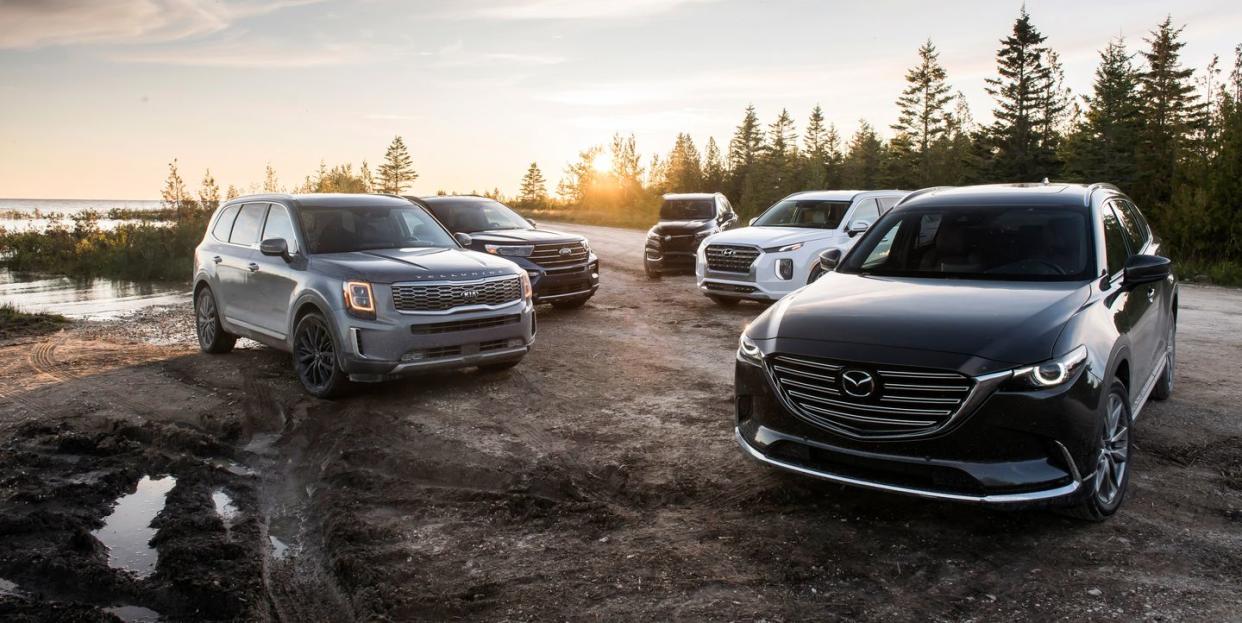
Hey, you. Yes, you. Don't pretend you just noticed something on the back of your hand or that your phone is buzzing in your pocket. We're talking to you. You who couldn't get enough of procreating and now need three rows of seating in a vehicle. We know you well enough to know that you don't want a minivan and that only a two-box crossover will do. Lucky for you, carmakers are swiping right on you, which explains the flood of new three-row products tailored for your life. There's so much churn in the class right now that, for most of our testers, this is our first exposure to three of these models.
Most promising is the Ford Explorer. It might look like a malnourished example of the last-generation model, all vacuum-packed bulge split by bone lines, but it's so new that the engine is facing a different direction, and if you don't opt for all-wheel drive, the torque goes only to the rear wheels. Ford's turbocharged 2.3-liter inline-four is on duty and has 300 horsepower and 310 pound-feet of torque turning the Ford/GM co-developed 10-speed automatic. The XLT is the lowliest Explorer trim, and this one packs all-wheel drive (a $2000 upcharge), 20-inch wheels ($1295), Ford's Co-Pilot360 Assist+ suite ($795), and a towing package ($710), for a grand total of $46,810.
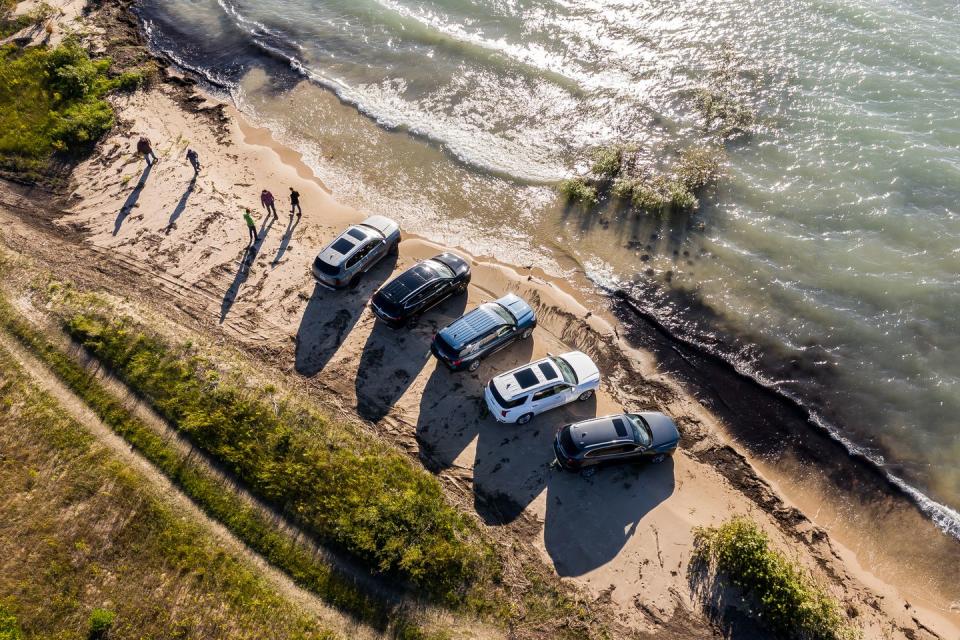
Hyundai and Kia have built three-row crossovers before, even big ones, but who besides us remembers the Veracruz and the Borrego? The Hyundai Palisade and Kia Telluride are the first big Korean crossovers poised to make a real mark on the segment. They share a lot, including their 291-hp V-6, eight-speed automatic transmission, and platform. Both have a 114.2-inch wheelbase, the test's shortest, but somehow the second-row seats are among the roomiest. At our $48,000 price target, you get a Palisade Limited with all-wheel drive, which means its window sticker abounds with standard equipment, from a pair of sunroofs to lane-keeping assistance to auto-leveling rear dampers. Toss in $160 for floor mats and this Palisade is a $47,655 proposition.
The Telluride's top trim level, SX, also includes stuff like the two sunroofs and the second-row captain's chairs, but it caters to a slightly more frugal buyer by leaving off a few extras. This one, of course, added them in with the $2000 SX Prestige package. Fully loaded, our Telluride came with ventilated second-row seats, richer leather, and a fake-suede headliner, among other goodies, for a final tally of $46,910.
Buick's second-gen Enclave is two years old, which makes it a slightly familiar member of the group. It remains related to the Chevy Traverse and is built on the same long version of the C1 platform. GM's corporate 3.6-liter V-6 makes 310 horses here and a nine-speed transaxle does the shifting. Our Essence-trim example is one step up from Buick's base model, and all-wheel drive adds $2000 to the chit. Spending an additional $1695 for the Sport Touring package nets 20-inch machined-face aluminum wheels and a unique grille. Powered front and fixed rear sunroofs cost $1400, while the $495 black paint and $270 set of floor mats land this Enclave at $49,055, the highest price in the test.
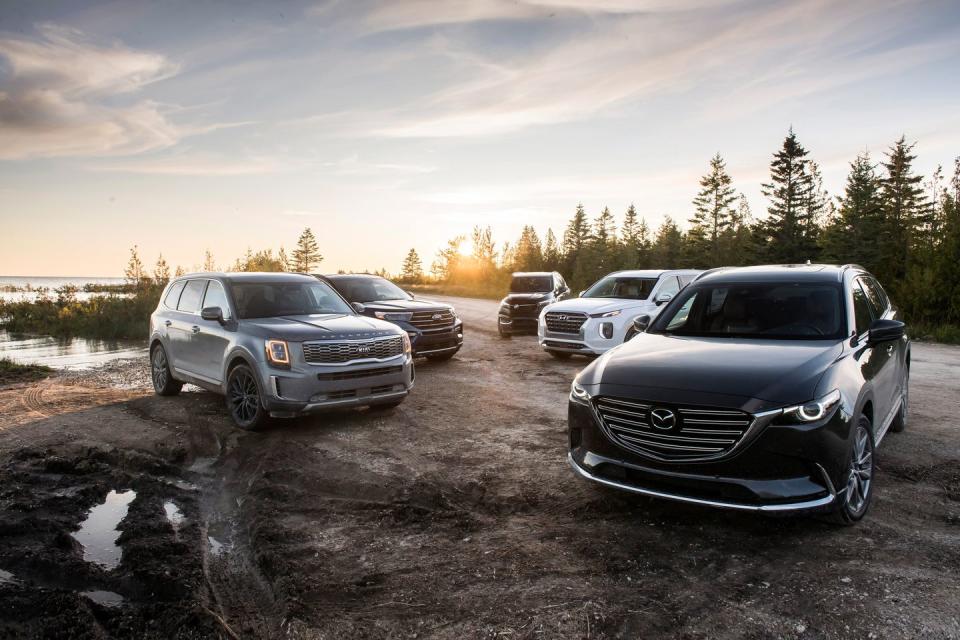
The Mazda CX-9 is the known quantity here, having been atop this hill for three 10Best awards as well as through two comparison tests in which it vanquished the Chevy Traverse, Honda Pilot, Subaru Ascent, and Volkswagen Atlas. Mazda isn't messing with success. The big news for the CX-9 this year is more standard equipment and available Android Auto and Apple CarPlay functionality. Mazda's 250-hp turbocharged four-cylinder and six-speed automatic are unchanged. Our Signature test vehicle stands at the top of the CX-9 mountain and includes all of Mazda's juiciest equipment—adaptive cruise, keyless entry and start, and the brand's G-Vectoring Control steering-feel-boosting system. Special paint, a cargo mat, and illuminated sill plates add $975 to the bottom line, bringing our Mazda to $47,385.

To see how the Mazda measures up against its latest competitors, we steered north to family-friendly Petoskey and then into the Upper Peninsula for the winding roads along Lake Michigan—which does, technically, experience semidiurnal water-level changes. Here we learned that the tide in this segment is indeed turning.
5th Place:
Buick Enclave

Highs: The any-way-you-fold-'em cargo champ and the passing-acceleration king.
Lows: The most money nets you the least stuff and a cheap-feeling interior.
Verdict: Remember the Buick Open? This is a time capsule from that era.
The competition in this segment is tough, so tough that we couldn't find a lot of nice things to say about the Buick. Someone did mention after a few rounds at Tap30 Pourhouse in Petoskey that the Enclave didn't seem to be the kind of vehicle a sex offender would drive.
Driving it revealed that its interior is richer and nicer than the Ford's, although that bar is dachshund-steeplechase low. And we can't even say that all the bits are nicer. Those $1400 sunroofs wear the sort of cheap spring-loaded retractable shades that slap when retracted, the kind you'd find in a Motel 6 or a Tom and Jerry cartoon. They would feel cheap in an old Volkswagen with a crank-operated sunroof. In a nearly $50,000, brand-new Buick, they're embarrassing.
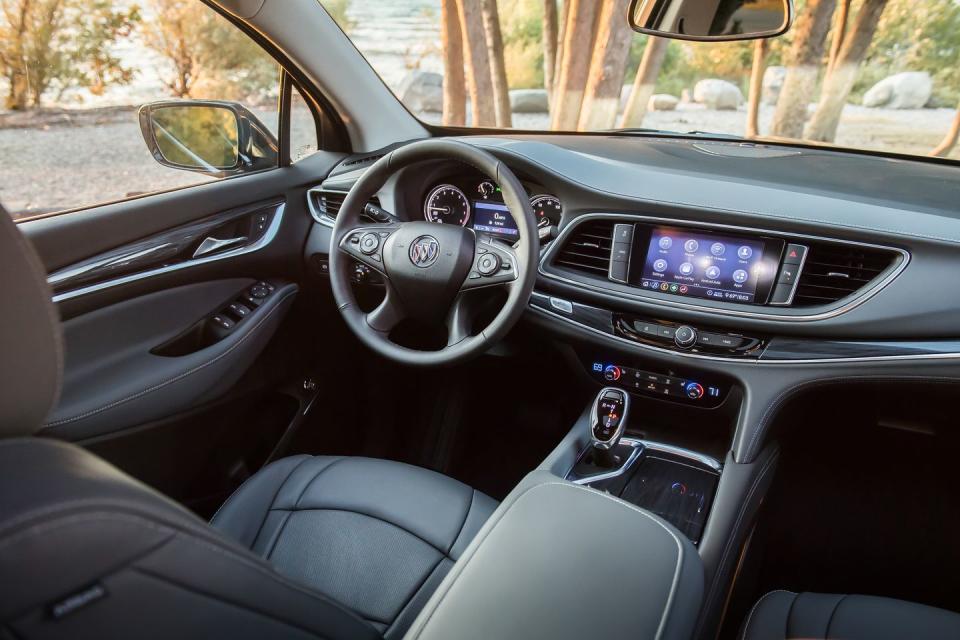
The 3.6-liter six-cylinder is always at the ready with power, but its coarseness is unbecoming a car that purports to be from a luxury brand. A lazy nine-speed automatic transaxle has smooth upshifts, but the other vehicles in this group manage seamless gearchanges without the sluggishness.
It's hard to love the vehicle that costs the most and offers the least content. The Enclave also lacks the design and materials to justify that premium price. The instrument panel appears to have received some attention from the designers, but the rest of the Buick's interior seems phoned in. The Essence trim doesn't even come with the factory navigation system; it's optional. But at least Android Auto and Apple CarPlay integration are standard.
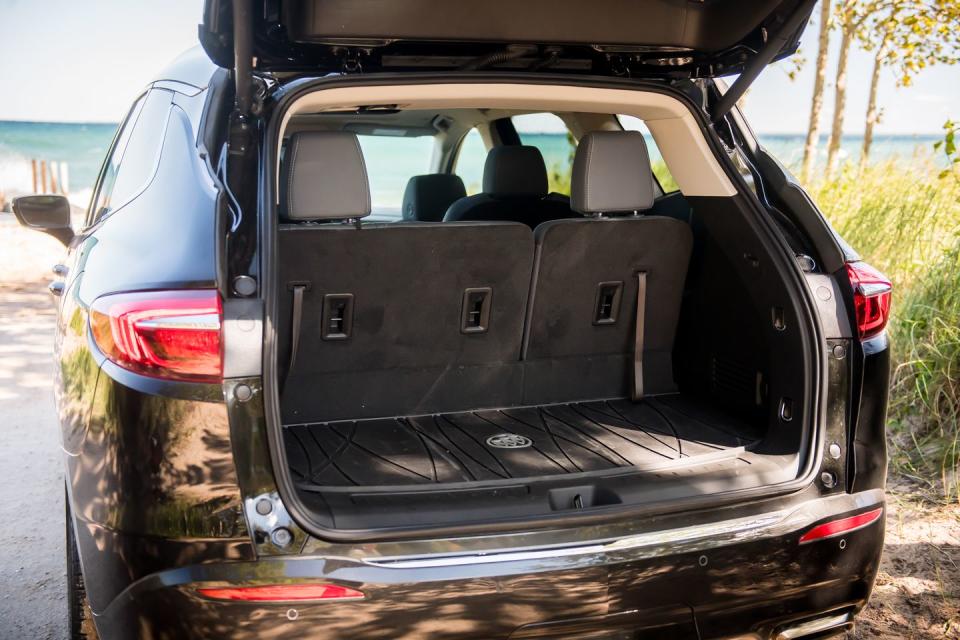
Buick's big infotainment innovation is that you can order pizza from your Enclave. GM's Marketplace app allows you to order food from Domino's, though not to your car. You can either go get it or have it delivered to your home. It's not worth getting into the details, but we will say that after an hour of trying to figure it out and set it up, we just dialed a phone and ordered an eight-corner deep dish from the nearest Jet's Pizza.
We were briefly excited when we noticed the ST badge on the Buick's liftgate. But then we remembered that those letters mean something cool on the Explorer. Here, they denote the Sport Touring package, but they might as well mean Sad Trombone.
4th Place:
Ford Explorer
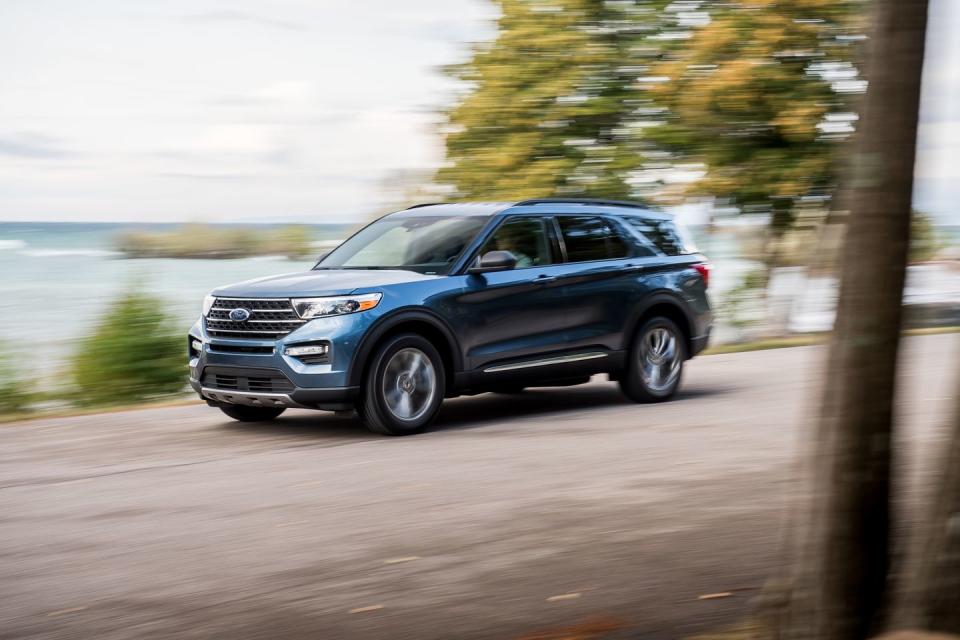
Highs: Longitudinal engine—just like a BMW!
Lows: Sparsely equipped and cheap inside—just like a last-generation Explorer.
Verdict: Ford lays the foundation for a brighter future but lets the Lincoln Aviator realize it.
Have you ever considered that maybe we've had it wrong all these years? That it's not supposed to be FoMoCo but in fact FOMO Co.? Just imagine the board meeting: "Hey, all those luxury brands seem like they're having a great time with longitudinal-engine, rear-drive SUVs. We used to do that. Let's do it again. YOLO!" In a homogeneous class, aiming the engine rearward is a gutsy way to stand out.
But the dynamic expectations fostered by the Explorer's new layout begin to fade as soon as you slide into the hard, flat seats. They offer little lateral support and were perhaps designed to make it easy for utility-belted police officers to slide in and out of. It's just as well, as the Explorer isn't as dynamic as we'd hoped. In an admittedly tight grouping, the Explorer finished last in the slalom and found itself in a three-way tie for worst on the skidpad. At least its braking distance was the shortest in the test.

Drive it as if you're on the way to the hospital when the contractions are four minutes apart and you'll find an unsettling discombobulation between the axles in response to anything other than the smallest steering input. Jerk the wheel to dodge a chunk of truck tire on the freeway and a moment passes before the rear end follows suit.
In less hurried driving, the 2.3-liter surges and lags like the highly boosted engine working against a lot of mass that it is. Flooring it does have its rewards. The Explorer managed the quickest zero-to-60 time in the group, although, at full whack, the mufflers emit a buffeting sound as though someone had lowered a rear window without cracking a front. If there's one part of a car engineered for smooth airflow, you'd think it'd be the exhaust system.
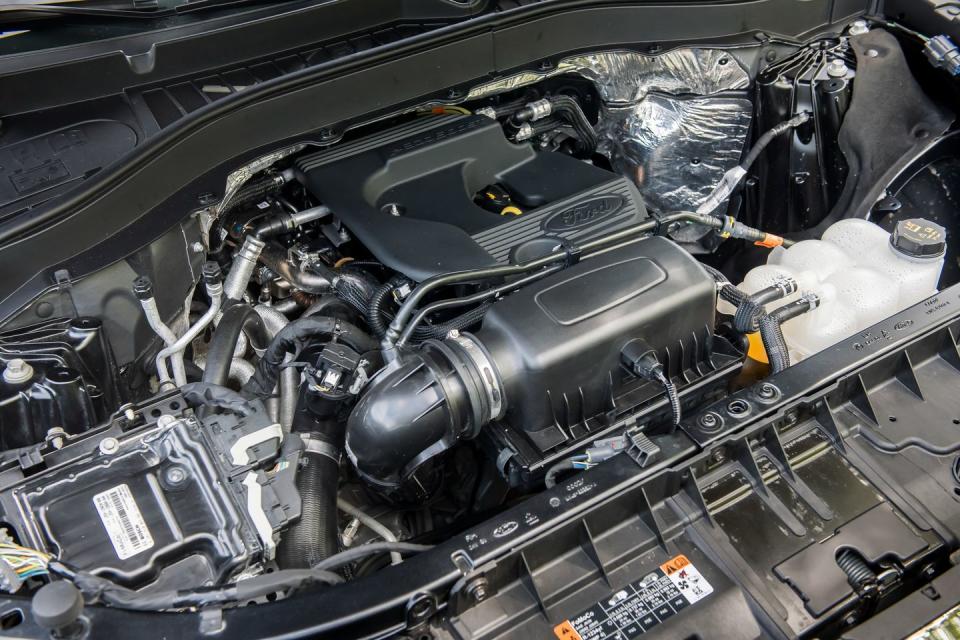
Senior editor Eric Tingwall was harshest when he wrote that the Ford's interior "isn't designed so much as cobbled together." In the Kia, no surface was overlooked. In the Ford, it seems few were looked at. The plastics are hard and unappealing, and the center-stack design appears efficient and clean until you realize that's simply because the Explorer doesn't have many goodies to manage. Our test vehicle didn't even have heated seats. Meanwhile, the Koreans not only heat their front and middle rows, they ventilate those seats as well.
The Explorer is remarkably solid. When the Buick came in at 91 pounds more than the Ford, we did a double take. The Ford feels like it should be the heaviest in this test by several hundred pounds. That solidity should serve it well in its inevitable police duty. Ford offers better Explorers, and the Aviator platform-mate is lovely and luxe, but Lincoln charges way more money for the improvements. Maybe the company ran a little low on R&D dollars after reorienting the engine 90 degrees.
3rd Place:
Mazda CX-9
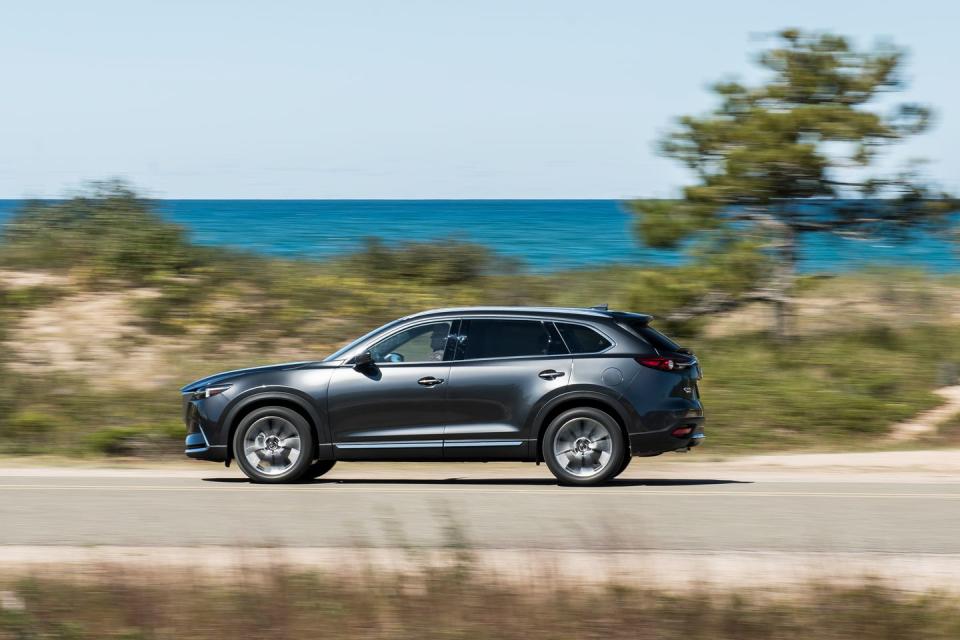
Highs: Still the undisputed driver's choice, comfortable even if it is small.
Lows: You can beat it for the money.
Verdict: Sports-car dreams drown in the sound of crying babes—or in a flood of Korean value.
The Mazda remains a class leader when it comes to handling corners and over-the-road confidence, but both Korean brands are close enough that the Mazda's edge isn't as compelling as it used to be.
The CX-9 is still the king of premium feel. Its design is understated compared with that of the Koreans, but there's a smooth richness to the leather and a satisfying click to the switchgear. The paint is flawless, and the wood inside is real.
Like the Explorer's engine, the CX-9's boosted four-cylinder alternates between surginess and reluctance. Mazda tuned the turbo for low-revving torque, and the CX-9's thrust tapers off at about 4500 rpm.

The Mazda's tight interior remains its weak spot. Soft padding and a comfortable angle to the third-row seat bottom make for more comfort than the numbers might have you think, but the Mazda's second-row bench—the only one in the test—entombs third-row inmates. Cargo space behind the seats is small—Miata small.
Android Auto and Apple CarPlay capability mark a monumental shift in infotainment, more significant than we'd initially realized. This is when a touchscreen becomes the way to go. Using the Mazda's rotary dial to operate the infotainment shows how clumsy it is to navigate a system designed for a touchscreen. There's a lot to love about the CX-9; we just want more CX-9.
2nd Place:
Hyundai Palisade
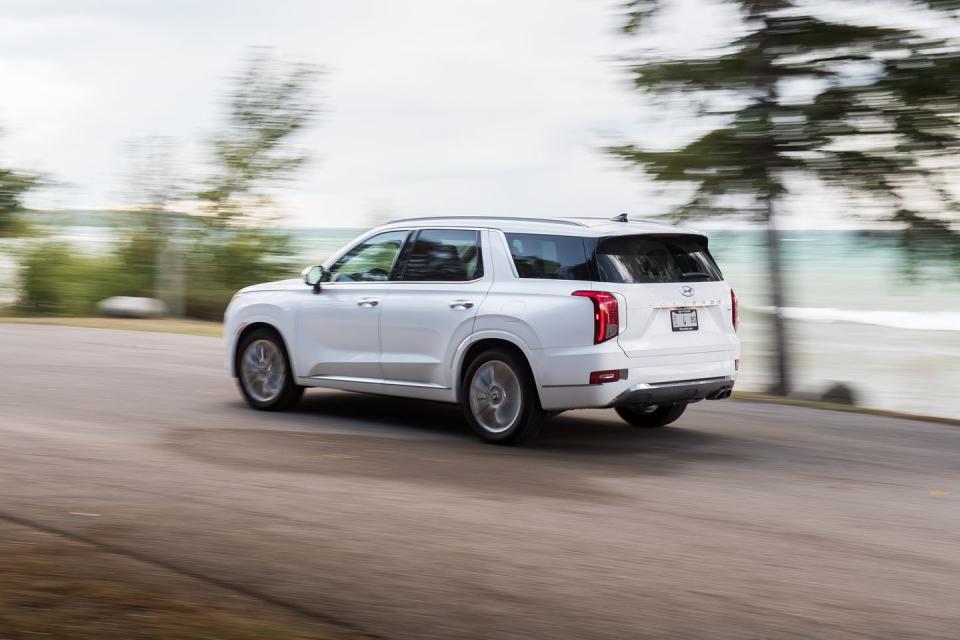
Highs: Everything you ever wanted, plus a few USB ports you didn't know you needed.
Lows: Could use an exterior design consult.
Verdict: If it's a spacious space fish you seek, Hyundai is probably running a good deal right now.
If you had heard the staff climbing into the Palisade the first time, you would've thought it was one of those obnoxious "real people, not actors" Chevrolet commercials. "Oh, man, check out the action on this seat-folding mechanism!" "Whoa. I've got three cupholders!" "If we were on a road trip, is that where you'd have your seat? I've got so much legroom!" Upon their exit from the vehicle, we checked everyone's pockets for fresh Benjamins. We're clean; the enthusiasm is genuine.

Clearly, we get excited about great packaging, such as the USB ports in the front seatbacks and the little mesh phone holsters below them. And for all the extras Hyundai packs into the Palisade—did we mention that the second-row seats are ventilated and that there's wireless phone charging, lane-keeping assist, dual sunroofs, an all-wheel-drive lock button, and on and on—everything is easy to operate. Tingwall noted: "I love the usability of a Hyundai/Kia interior. I had never been in a Palisade, but there's no learning curve."
Familiar and accessible don't mean cheap or unimaginative, though. A couple editors wondered why the quilted leather in the door panels needed to be perforated, but no one could deny the thought and care that went into every facet of the Palisade's interior. Even the mouse-fur headliner appears to be only the finest mouse fur. Corinthian mouse fur.
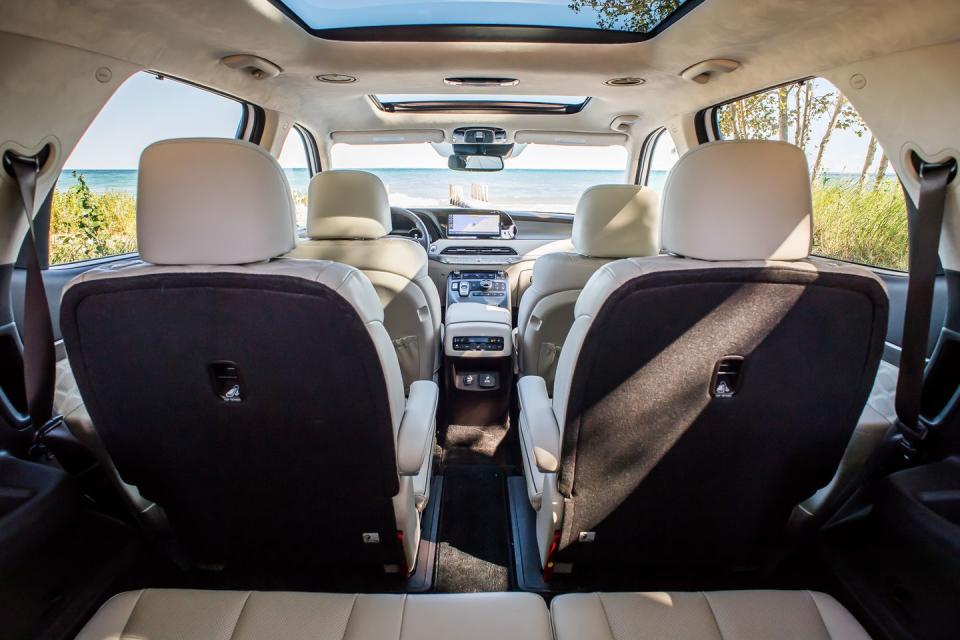
The Hyundai doesn't quite match the verve of the Mazda, but it comes close enough for something with three big rows. Body control is tight. It's luxuriously supple over scarred roads. The steering is sharp and light, if numb. We won't call it lifeless, though. There was life on Earth for billions of years before we came along; Hyundai's steering has a simple, single-cell sort of feel to it.
The same sort of inoffensive sufficiency is under the hood. The 3.8-liter V-6 isn't turbocharged, and the transmission isn't co-developed with a rival. What we have here is just a V-6—kind of a big one—and an eight-speed automatic. It's not trying to be clever or exciting. It purrs under full throttle and is pretty smooth all the time. It won't goad you into lawlessness, but neither will it disturb your morning introspection.
That serenity inspired one of our logbook scribblers to dub the Palisade the "S-class of the segment." Someone else asked, "Shouldn't this be a Genesis?"
[Spotlights illuminate a previously unseen Palisade.] "Wait. You're telling me this is a Hyundai?"
1st Place:
Kia Telluride
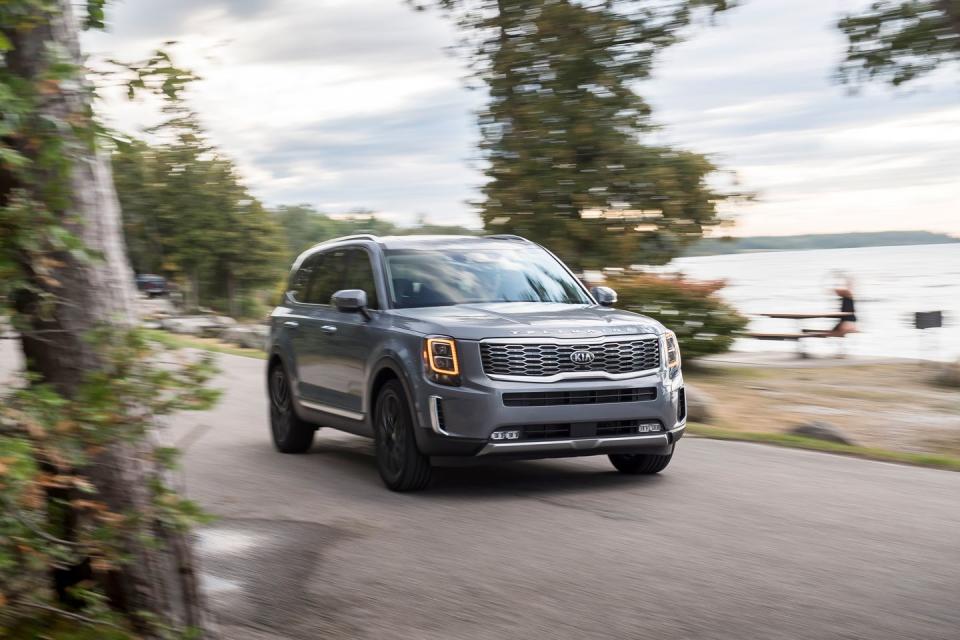
Highs: All the strengths of the Hyundai, plus a rugged and not-weird shape.
Lows: The skinny tires are so hard not to stare at.
Verdict: Give the people what they want and they'll return the favor with laurels—and sales.
Staff editor Andrew Wendler doesn't usually spout conspiracy theories. But by the time he got out of the Telluride, he'd nurtured a good one: "The South Korean government is propping up Hyundai and Kia. How else can you explain how good these two are?"
It's nearly impossible to discuss the Telluride and Palisade separately, as they are more similar in feel than most platform-mates are. But that's fine by us, because they look nothing alike and because the biggest commonality is excellence. Choosing between the two is really about which one looks better to you. For us, it's the Telluride.

The Kia's broad shoulders and blocky styling give it nearly as much of a rear-drive look as the actual rear-drive-based Explorer. The earth-tone exterior palette and a heavy dose of Land Rover Range Rover in the styling feed our Rough Rider fantasies. If we owned one, it'd have a "Teddy Roosevelt for President" bumper sticker.
The macho look continues inside, with leather abutted by convincing imitations of satin metallic trim and open-pore wood that appear to be rescued from a Tombstone saloon. Unlike a saloon, the Telluride is so serene that we kept assuming the adaptive cruise had seen a car ahead and was slowing down. A glance at the speedo—or the head-up display—would confirm that we were maintaining the expected clip. This adept masking of speed is common in high-end vehicles, but we've never seen it so well done in something at this price point.
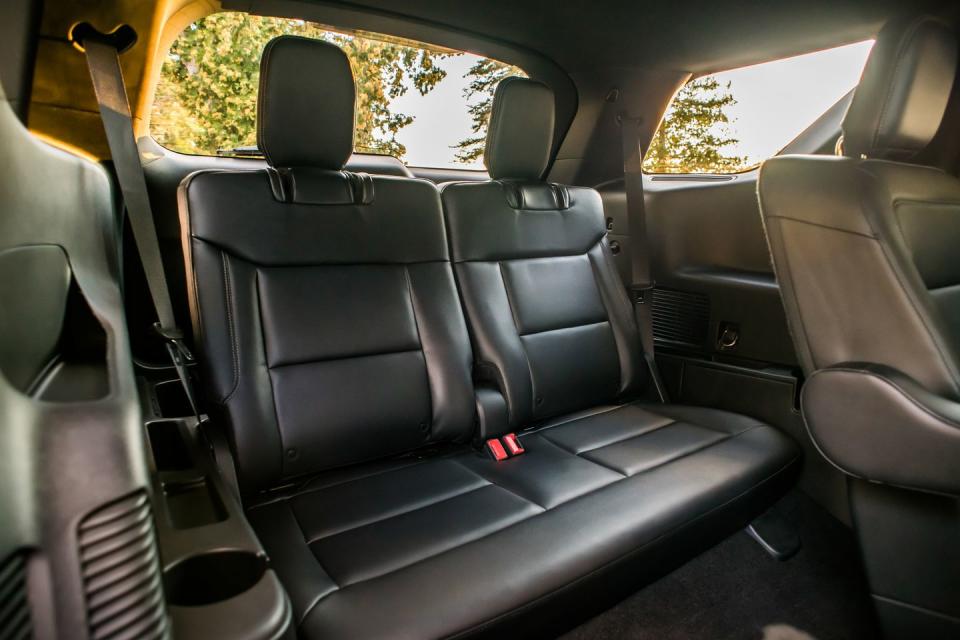
Long rear doors and a second-row seat that quickly folds and slides out of the way allow for easy third-row access, and the enormous second-row space meant that the Koreans were the only vehicles here in which middle passengers were willingly sliding their seats forward to grant those in the wayback more legroom. The debate over which third row was most comfortable, the Hyundai's or the Kia's, boiled down to individual passenger shape and how naturally our heads fit with the sculpting of the D-pillars if we decided to lean against them and sleep. In the other vehicles, we never stayed back there long enough to relax. Apart from the Korean twins, all the other vehicles elicited complaints about how tightly our knees were pressed into seatbacks or how hard and flat the bottom cushions were. If you're regularly hauling three rows of people—and hoping to impress them—the Hyundai and Kia are your answer.
They're not flawless, though. The wheels and tires look a little skinny from some angles. When slammed, the doors shake the whole vehicle. And over big bumps, there's more shimmy through the structure of the twins than you'll feel in the others. But the look and finish are such that not even a few quivers can pierce the upscale atmosphere. Not long ago, paying $50,000 for a Kia would have seemed ridiculous. Now there's one that seems like a ridiculous steal at $50,000.
From the November 2019 issue.
You Might Also Like

